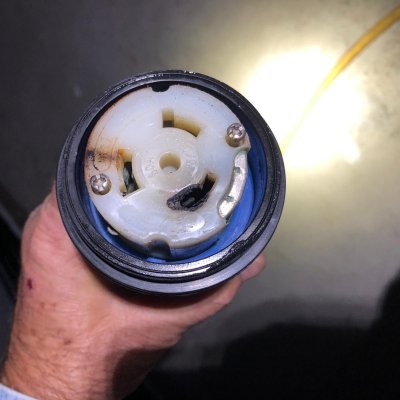RickyD
Guru
- Joined
- May 4, 2018
- Messages
- 729
- Location
- United States
- Vessel Name
- Aquarius
- Vessel Make
- Californian 55 CPMY
So, if you have read my other thread about my heat exchanger dying, I'm in the "what's next mode". I'm on the boat day before yesterday to continue flushing my engine. I start cooking breakfast and half way through, my range top quits with an error msg. I look at the breakers, ok, I look at the incoming power and oops, I have one 120v leg and the other is reading 30v a/c. So I wiggle and twist all my connectors (I have 3, pedestal, boat and extension) on my 50 amp cable. Still 30v. So, I disconnect my extension, and there it is, burned contacts. Must have gotten water in at the last rain. But, to be sure I check at the pedestal and indeed I have 120v on two legs. Good news is I was there and I checked the my charger and I was on the inverter. If I was not to be there for some time = depleted batteries, spoiled food, etcetera. Ok, start the generator, two 120v legs. I Charge the batteries but I had to go home and leave it on inverter. So, yesterday I check Lowes, they have a new female 50 amp connector for $65 but special order only. I check Home Depo, same price, same situation. Well I need one now, local electrical warehouse, no gots. Crap, off to West Marine and I get to spend $129 for the same thing. Well anyway no easy task replacing the old one. Tried to take it apart, no dice. Had to cut the cable and install the new one. But the new expensive one is not anything close to the water proofing of the old one. It works but now I get to spend more to buy the heavy cover for water proofing. My mechanic opines that as soon as one thing is fixed, the next will break. He suggests I don't fix the next non-critical problem otherwise for sure the next shoe will drop.





